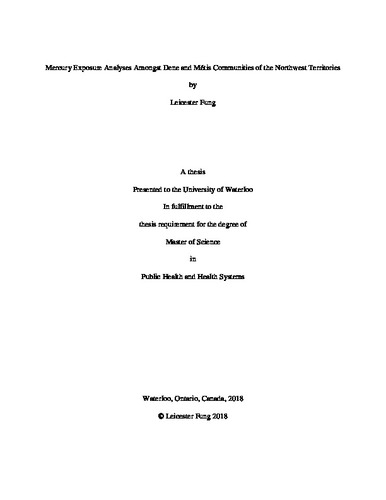| dc.description.abstract | Background: Fish is an important food source for many Indigenous communities within the Dehcho and Sahtú regions of Northwest Territories (NWT). However, environmental toxicants, such as mercury (Hg), can bioaccumulate and biomagnify to reach detectable levels in fish, particularly among predatory fish species. From a public health perspective, Hg exposure and biomonitoring assessments are invaluable assets that can highlight potential risk factors and evaluate risks associated with Hg toxicity. With the current body of knowledge, exposure assessment models conservatively account for Hg bioaccessibility in fish to be 100% because of the limited information available. Past literature have also noted statistical differences in Hg bioaccessibility with respect to food source as well as food preparation methods. As such, there is a need for more Hg biomonitoring and Hg bioaccessibility assessments to elucidate the relationships between dietary and demographic determinants with respect to Hg exposure.
Objectives: Hg biomonitoring component. 1) To determine internal Hg exposure levels (blood and hair) from six Indigenous communities in the Dehcho and Sahtú regions of NWT. 2) To conduct t-test analysis for internal Hg exposure levels with respect to sex. 3) To construct simple linear regression models between internal Hg exposure levels with the following factors: i) age ii) non-piscivorous fish consumption iii) piscivorous fish consumption.
Hg bioaccessibility component. 1) To characterize Hg concentrations for uncooked and dried by smoking (dried/smoked) lake whitefish (Coregonus clupeaformis). 2) To determine Hg bioaccessibility in uncooked and dried/smoked lake whitefish. 3) To conduct t-test analysis to determine Hg concentration and Hg bioaccesibility differences between uncooked and dried/smoked whitefish.
Methods: Hg biomonitoring component. 150 Dene and Métis participants, between the ages of 6-79, were recruited from Deline, Fort Providence, Hay River Reserve, Kakisa, West Point First Nation and Jean Marie River of NWT. Blood and hair samples were collected for internal Hg exposure assessments. Participants were also asked to provide demographic information and complete a food frequency questionnaire (FFQ) for describing potential determinants of Hg exposure. T-test analysis and log-linear simple regression models were used to identify individual relationships.
Hg bioaccessibility component. Five whole lake whitefish (Coregonus clupeaformis) were used to investigate Hg bioaccessibility. Subsamples were subjected to two treatments: uncooked and dried/smoked. All dried/smoked and uncooked fish samples underwent a single phase (gastric only) IVBA model treatment. All Hg concentrations were expressed as wet weight and determined using an Ohio-Lumex portable mercury analyzer with pyrolyzer attachment.
Results: Hg biomonitoring component. Hg levels in blood and hair were highly linearly-correlated with one another (r= 0.854, p<0.05) and all of the participants had blood and hair Hg levels below 20μg/L and 6μg/g respectively. T-test analysis found no statistical differences (p>0.05) when comparing blood Hg levels of male and female participants (2.711 ± 2.616 µg/L and 2.667 ± 4.079 µg/L respectively) Similarly, T- test analysis found no statistical differences (p>0.05) when comparing hair Hg levels of male and female participants (0.868 ± 0.925 µg/L and 0.671 ± 0.866 µg/g respectively). According to the simple regression model’s findings, age was the only statistically significant factor and was positively associated with blood and hair Hg levels (B=0.020 and p<0.01; B=0.011 and p<0.01). Based on simple regression model’s findings, piscivorous fish consumption was not significantly associated with either Hg levels found within blood and hair (B= 0.068 and p>0.05; B= 0.023 and p>0.05). Similarly, non-piscivorous fish consumption does not appear to be significantly associated with blood and hair Hg levels (B= 0.022 and p>0.05; B= 0.035 and p>0.05)
Hg bioaccessibility component. After culinary treatment, dried/smoked whitefish samples retained, on average, 46% of their original mass (i.e., due to moisture loss). As a result of moisture loss, the initial Hg concentration in dried/smoked whitefish samples (0.194 mg/kg) was significantly greater (p=0.002) relative to uncooked whitefish samples (0.080 mg/kg). When comparing Hg bioaccessibility, dried/smoked whitefish (53%) was statistically lower (p< 0.001) compared to uncooked whitefish (102%). Despite the reduction in Hg bioaccessibility for dried/smoked whitefish, the bioaccessible Hg concentration in dried/smoked whitefish (0.101 mg/kg) was significantly greater (p< 0.05) compared to uncooked whitefish samples (0.081 mg/kg). The loss of moisture mass and the increased density of Hg within dried/smoked whitefish samples were likely responsible for the increase in total and bioaccessibile mercury in dried/smoked whitefish. As such, dried/smoked whitefish samples had greater amounts of Hg digested and solubilized in aqueous solution.
Conclusion: Both simple regression and static IVBA models’ findings have provided additional information for characterizing Hg exposure among participating communities in Northwest Territories. Based on the study population’s demographic determinants and dietary patterns, age is a key factor for understanding and predicting Hg exposure in the Northwest Territories. Bioaccessibility findings suggest source apportionment models that incorporate differences in Hg concentration between raw and smoked/dried fish may also need to account for the corresponding difference in bioaccessibility. For further generalizability of IVBA model’s findings, additional in vitro bioaccessibility studies using different fish species are needed. This research is important because it highlights dietary factors, such as cooking method, are potentially important to human exposure. Inclusion of such factors to source apportionment model may help further characterize the relationship between internal Hg exposure levels detected in biomarkers and the external exposure estimates. | en |

